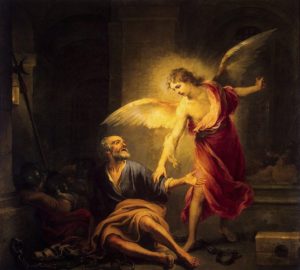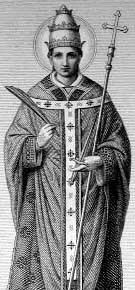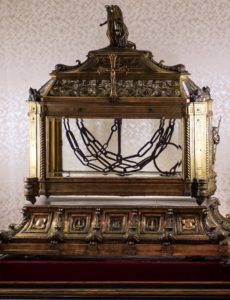The Golden Legend of St. Peter’s Chains
 The feast of St. Peter’s Chains on August 1st primarily focuses on the Apostle’s angelic deliverance from his imprisonment by Herod, as recounted in Acts 12. The folklore surrounding the feast also tells of two sets of chains: those used by Herod in Jerusalem, and those used during Peter’s imprisonment under Nero at the Mamertine prison in Rome. Printed below are modernized excerpts from the popular medieval work, the Golden Legend of the Saints, which discusses how the chains were recovered and the feast established in Rome.
The feast of St. Peter’s Chains on August 1st primarily focuses on the Apostle’s angelic deliverance from his imprisonment by Herod, as recounted in Acts 12. The folklore surrounding the feast also tells of two sets of chains: those used by Herod in Jerusalem, and those used during Peter’s imprisonment under Nero at the Mamertine prison in Rome. Printed below are modernized excerpts from the popular medieval work, the Golden Legend of the Saints, which discusses how the chains were recovered and the feast established in Rome.
The Feast of St. Peter ad Vincula, at Lammas
…Pope Alexander, who was the sixth after Peter, and Hermes, provost of Rome, who was converted to the faith by Alexander, were held in prison at different places by Quirinus the judge. The judge said to Hermes the provost:
“I marvel that you, who are so wise a man, would abandon the great worldly honors that you have, and the great riches that you receive from the office of provost, and leave all these things for the dream of another life.”
To whom Hermes said:
“Before now I despised and scorned it, and I supposed there had been none other life than this.”
Quirinus answered: “Prove to me that there is another life, and I shall join myself to your faith.”

Hermes said: “Alexander, whom you hold in prison, shall inform you better than I.”
But Quirinus cursed Alexander, and said to him: “I want you yourself to prove this thing to me, and instead you direct me to Alexander, whom I have bound in chains for his evil deeds. Now I shall double the guards upon you and Alexander, and I shall set a watch. And if I find you with him or him with you, I will believe that you speak the truth.
Then he doubled their guards and told Alexander. Alexander prayed to God, and an angel came to him and brought him into the cell with Hermes. And when Quirinus came to the cell he found them both together, which caused him great amazement. And then Hermes recounted to Quirinus how Alexander had healed his son and raised him from death.
Quirinus then said to Alexander: “I have a daughter named Balbina who is sick with a goiter. If you can heal her, I promise that I shall accept your faith.”
Alexander replied: “Go then, and bring her to me into my cell.”
And Quirinus said to him: “How can I find you in your cell, when you are here?”
Alexander said: “Go your way, for He that brought me here shall soon bring me back there.”
Quirinus then went and fetched his daughter, and brought her to Alexander’s cell where he found him inside, and then he knelt down at his feet. And his daughter began to kiss the chains with which Alexander was bound, hoping thereby to receive her health.
But Alexander said to her: “Daughter, do not kiss my chains, but seek the chains of St. Peter and kiss them with devotion, and thou shalt receive thy health.”

So Quirinus set out to seek the chains of Peter, and these were found. And Alexander bade his daughter to kiss them. As soon as she had done so, she received her health and was all whole. Then Quirinus demanded pardon and forgiveness, and delivered Alexander out of prison, and received holy Baptism: he and all his attendants and many others. Then Alexander established this holy feast to be kept always on the first day of August, and he made a church in honor of S. Peter, where he set the chains and named it St. Peter ad vincula.
And to that church come many people at that solemnity, and the people there kiss the bonds and chains of St. Peter.
…..
The month of August was formerly called Sextilis. The people dedicated and named it after Augustus in honor and remembrance of the victory that the emperor had on the first day of this month. All the Romans kept that day as a great solemnity until the time of Theodosius the emperor, who began to reign in the year of our Lord 426.
At that time Eudosia, daughter of the said Theodosius the emperor, and wife of Valens, went by a vow to Jerusalem. There a Jew gave to her for great love a great gift: the two chains with which St. Peter was bound under Herod. She was overjoyed at this, yet when she returned to Rome she saw that the Romans kept the first day of August in honor of a dead pagan emperor. She was very sorrowful because they gave so much honor to a man who was damned, and she thought that they would not lightly give up this custom. If possible, she wished not to leave the day as it then was, but to remake it instead in honor of S. Peter, that all the people should call it St. Peter ad Vincula.
And she discussed the matter with St. Pelagius the Pope, then declared with fair words that the prince of pagans was now forgotten, and the memory of the prince of the apostles would be kept instead. And this pleased all the people. Then she brought forth the chains that she had brought from Jerusalem, and showed them to the public. Then the pope brought out the chain with which Peter had been bound under Nero, and as soon as that chain touched the others, all three by a miracle were made one, as if they had never been separated.
The pope and the queen thus established that the people’s foolish custom of making solemnity of a pagan, was changed into a better one for St. Peter, prince of the apostles. And the pope and the queen set the chains in the church of St. Peter ad Vincula. And the queen gave to said church great gifts and privileges, and it was established that day to be hallowed over all.
July 30, 2020








